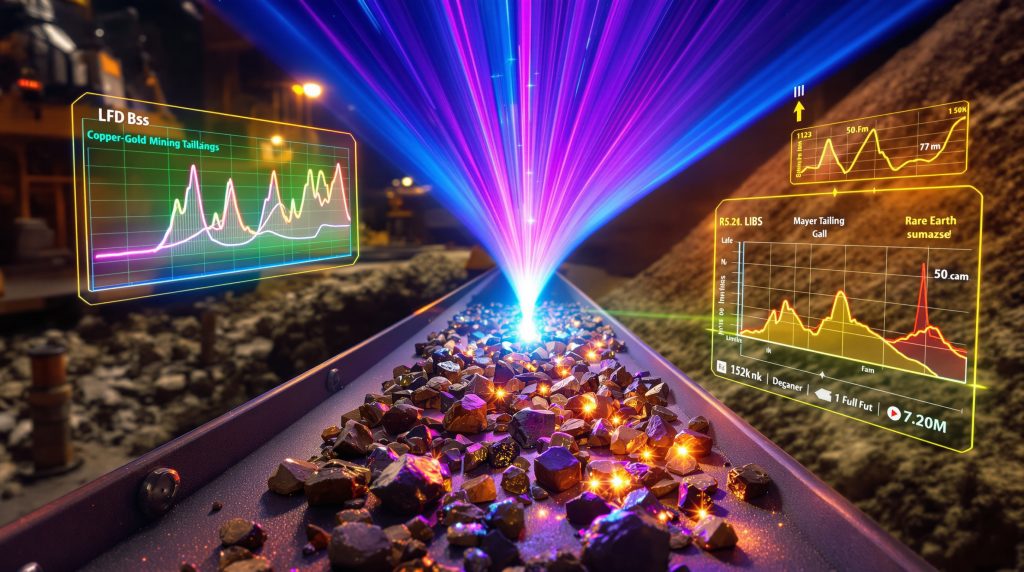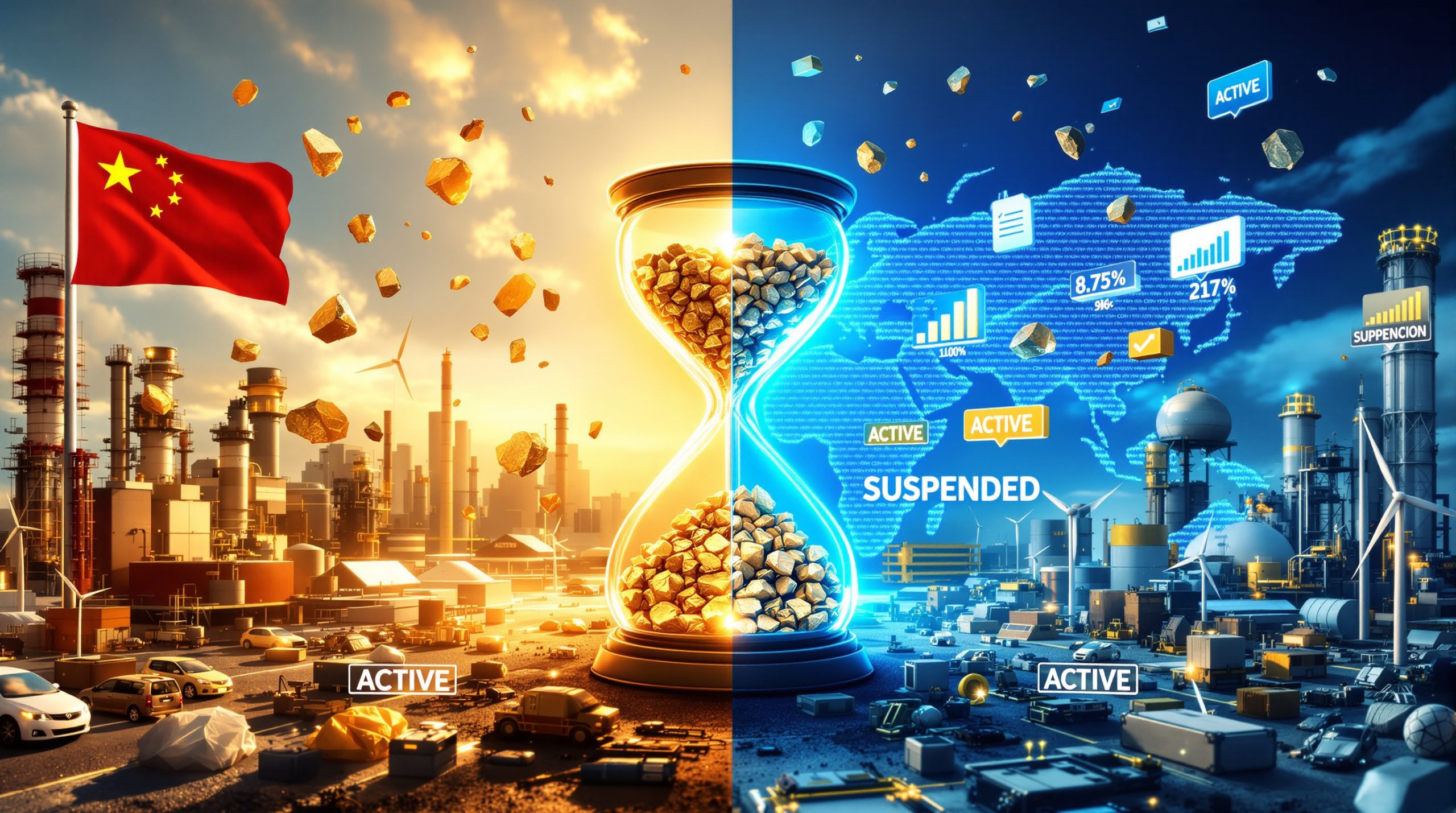Revolutionizing Sustainable Mining: How LIBS Technology Transforms Resource Extraction
What is LIBS and Why is it Critical for Sustainable Mining?
LIBS (Laser-Induced Breakdown Spectroscopy) represents a transformative analytical technology that provides real-time elemental composition analysis of materials. This advanced spectroscopic method works by focusing a high-energy laser pulse onto a material's surface, creating a plasma that emits light at wavelengths characteristic of the elements present. The technology enables instant identification and quantification of virtually all elements in the periodic table without complex sample preparation.
In the mining sector, where sustainable mining transformation challenges continue to mount, LIBS offers a revolutionary approach to resource management. The global LIBS market was valued at approximately $245 million in 2023 and is projected to reach $425 million by 2030, representing a CAGR of 8.2% as mining companies increasingly adopt this technology to address declining ore grades and stringent environmental regulations.
LIBS technology delivers significant advantages including real-time material characterization directly on conveyor systems, precise separation of valuable minerals from waste rock, and substantial reductions in energy and water consumption. Additionally, it enables minimization of environmentally harmful tailings and extends mine lifespans through processing previously uneconomic ores.
The Technical Foundation of LIBS Analysis
LIBS technology operates through a four-stage process that occurs in milliseconds:
-
Laser ablation – creating a microscopic crater on the sample surface using Nd:YAG lasers operating at wavelengths of 1064 nm or 532 nm with pulse energies ranging from 10-200 mJ
-
Plasma formation – generating an energetic plasma from the ablated material, with temperatures reaching 10,000-20,000 Kelvin
-
Light emission – producing element-specific spectral lines during the plasma's 1-10 microsecond lifetime
-
Spectral analysis – identifying and quantifying elements based on their unique spectral signatures within 0.1-10 microseconds after plasma formation
This process enables throughput rates of 60-600 samples per minute in industrial applications, providing the real-time analysis that traditional laboratory methods cannot match.
How Does LIBS Transform Resource Efficiency in Mining Operations?
Precision Ore Sorting and Pre-Concentration
The integration of LIBS sensors into mining operations revolutionizes resource efficiency through sensor-based sorting (SBS). Industrial LIBS sensors can analyze materials moving at belt speeds up to 3.5 meters per second, with typical installations analyzing 20-100 points per second across conveyor widths.
By embedding LIBS analyzers into conveyor systems, mining operations can:
-
Analyze materials before energy-intensive crushing and grinding
-
Instantly classify particles as either valuable mineral or waste rock
-
Immediately reject barren material from the processing stream
-
Reduce energy consumption by 18-35% in downstream processes
-
Decrease water usage by 20-40% compared to conventional methods
This capability proves particularly valuable as global ore grades continue to decline, with average copper ore grades falling from approximately 1.5% in 1900 to 0.6% in 2020, requiring more material to be processed for the same mineral yield.
Real-Time Decision Making and Operational Optimization
LIBS technology enables data-driven operations to make decisions in real time, fundamentally changing operational dynamics. According to research from the University of Queensland's Sustainable Minerals Institute, "real-time analytical technologies enable mining operations to make informed decisions within seconds rather than hours or days, fundamentally changing the economics of processing low-grade deposits."
This transformation leads to:
-
Immediate grade control and material routing decisions
-
Reduced reliance on time-consuming laboratory assays
-
Optimized blending of materials to maintain consistent feed quality
-
Enhanced productivity through continuous process optimization
-
Decreased carbon footprint by minimizing unnecessary material transport
What Role Does LIBS Play in Advancing the Circular Economy?
Precision Recycling and Material Recovery
Beyond primary extraction, LIBS technology serves as a cornerstone for the circular economy through enabling selective recycling. With global e-waste generation reaching 62 million metric tonnes in 2022, containing an estimated 350,000 tonnes of copper and significant quantities of precious metals, precise sorting technologies are critical.
LIBS offers unprecedented advantages in recycling operations:
-
Accurate identification of different metal alloys in mixed scrap with the ability to distinguish between aluminum alloy grades that differ by less than 1% in composition
-
Precise sorting of materials with subtle compositional differences
-
Prevention of cross-contamination in recycled products
-
Enhanced recovery of strategic metals from complex waste streams
According to research published in Resources, Conservation and Recycling, "spectroscopic sorting technologies enable unprecedented precision in material separation, critical for maintaining material quality in closed-loop recycling systems."
Critical Raw Material Recovery from E-Waste
The application of LIBS in e-waste processing demonstrates its transformative potential, particularly in the lithium-ion battery recycling market, which is projected to grow from $6.5 billion in 2023 to $35.1 billion by 2031.
Research conducted by the ReCell Center demonstrated that LIBS can identify different lithium-ion battery chemistries (NMC, NCA, LFP) with over 95% accuracy, enabling efficient sorting prior to recycling. Studies indicate that LIBS-enabled sorting can improve recovery rates for critical materials from e-waste by 20-50% compared to conventional mechanical sorting methods, though exact improvements vary by material type and processing configuration.
How Does LIBS Ensure Quality Control in Bulk Materials?
Impurity Detection in Mineral-Derived Products
LIBS technology provides powerful analytical capabilities for quality control across various bulk materials, particularly in the fertilizer industry. With detection limits for cadmium in phosphate matrices of 5-15 mg/kg and precision (RSD) for major nutrients (N, P, K) typically 2-5%, LIBS offers:
-
Simultaneous quantification of macronutrients (N, P, K)
-
Measurement of essential micronutrients in both solid and suspension fertilizers
-
Detection of toxic elements at trace levels (Cd, Pb, As, Cr)
-
Real-time batch release decisions based on immediate analytical results
This application is especially important in regions with stringent regulatory standards for consumer and agricultural safety, such as the European Union, which has established EU Regulation 2019/1009 setting maximum cadmium limits in phosphate fertilizers at 60 mg/kg P₂O₅ as of 2019, decreasing to 20 mg/kg P₂O₅ by 2026.
Preventing Contamination in the Agricultural Supply Chain
The ability to detect harmful elements in fertilizers derived from mineral sources addresses a critical environmental and food safety concern. According to the European Chemicals Agency (ECHA), "rapid analytical methods that enable real-time quality control are becoming essential for fertilizer manufacturers to demonstrate compliance with increasingly stringent heavy metal limits."
A pilot study conducted by the Joint Research Centre (JRC) of the European Commission evaluated LIBS for phosphate fertilizer quality control, demonstrating detection of cadmium at concentrations below regulatory limits with correlation coefficient (R²) values exceeding 0.95 compared to reference methods.
This capability helps prevent the introduction of toxic elements into agricultural ecosystems and aligns with increasingly strict global safety standards while offering significant advantages over traditional analytical methods in terms of analysis time, sample preparation requirements, and cost per analysis.
What Environmental Benefits Does LIBS Technology Deliver?
Reduced Waste and Environmental Footprint
The implementation of LIBS technology across mining operations delivers multiple environmental benefits in an industry that generates approximately 100 billion tonnes of waste rock and tailings annually. According to research from the Mining Association of Canada, "pre-concentration technologies that enable early waste rejection can reduce tailings volumes by 20-60% depending on ore characteristics, significantly decreasing environmental risks and tailings storage facility requirements."
Key environmental improvements include:
-
Decreased waste rock and tailings volume by 20-50%
-
Reduced chemical reagent consumption in mineral processing
-
Lower energy requirements for crushing, grinding, and concentration
-
Minimized water usage through more efficient processing
-
Extended mine life, reducing the need for new mine development
Carbon Emission Reductions
LIBS-enabled operations demonstrate significant carbon footprint improvements through multiple pathways:
-
Decreasing energy consumption in processing by enabling early waste rejection
-
Reducing transportation requirements for samples and materials
-
Minimizing water pumping and treatment needs
-
Extending mine life to delay new mine development with its associated carbon-intensive construction phase
A study of copper mining operations in Chile implementing sensor-based sorting documented 22-28% reduction in total energy consumption per tonne of copper produced, 18-25% decrease in freshwater consumption, and 35-42% reduction in tailings volume.
These reductions align with global initiatives to decrease mining's environmental impact while maintaining essential material supplies.
What Are the Economic Advantages of LIBS Implementation?
Cost Efficiency and Operational Benefits
The economic case for LIBS implementation in mining operations is compelling, particularly when considering that crushing and grinding costs typically range from $4-12 per tonne of ore processed. The technology delivers multiple economic benefits:
-
Reduced processing costs through early waste rejection, including lower grinding media consumption, decreased liner wear in mills, and reduced flotation reagent consumption
-
Lower energy costs through decreased electricity consumption in comminution and reduced pumping requirements for lower slurry volumes
-
Decreased waste management costs, including smaller tailings storage facility requirements, lower water treatment volumes, and reduced environmental monitoring requirements
-
Increased recovery of valuable minerals
Extending Mine Viability and Resource Utilization
According to analysis from the International Institute for Sustainable Development (IISD), "sensor-based technologies enable mining operations to process lower-grade deposits economically by reducing unit costs through waste rejection, potentially extending mine life and delaying closure-related economic impacts on mining communities."
Research from the Helmholtz Institute Freiberg documented that sensor-based sorting systems in copper operations achieved payback periods of 18-36 months, with annual cost savings of €2-5 million for operations processing 5-10 million tonnes per year.
LIBS technology enables mining operations to:
-
Process previously uneconomic low-grade ores
-
Extend mine lifespans through improved resource utilization
-
Recover valuable minerals from historical waste dumps
-
Maintain profitability despite declining ore grades
-
Reduce capital requirements for new mine development
How Is LIBS Technology Evolving for Future Mining Applications?
Integration with Artificial Intelligence and Machine Learning
The next frontier for LIBS in sustainable mining involves integration with AI in mining technology:
-
Machine learning algorithms for improved mineral identification
-
Predictive maintenance of mining equipment based on material composition
-
Automated process optimization responding to changing ore characteristics
-
Real-time decision support systems for mining operations
-
Digital twin development for virtual testing of operational changes
This integration will enable mining operations to extract even more value from the spectral data generated by LIBS systems, further enhancing operational efficiency and sustainability.
Miniaturization and Field Deployment
Technological advancements are making LIBS increasingly accessible for field applications:
-
Handheld LIBS devices for exploration and in-field analysis
-
Drone-mounted systems for remote sensing and mapping
-
Underground deployment in autonomous mining operations
-
Integration with drilling equipment for real-time exploration data
-
Ruggedized systems capable of operating in extreme mining environments
These developments will extend the benefits of LIBS technology from central processing facilities to exploration and remote mining operations, providing comprehensive elemental analysis capabilities throughout the mining value chain.
What Challenges Must Be Addressed for Wider LIBS Adoption?
Technical and Implementation Considerations
Despite its transformative potential, several challenges must be addressed for wider LIBS adoption:
-
Calibration requirements for diverse mineral matrices
-
Data management for the high volume of analytical information
-
Integration with existing mining infrastructure and workflows
-
Training requirements for operational personnel
-
Initial capital investment for technology implementation
These challenges require collaborative efforts between technology providers, mining operators, and research institutions to develop standardized approaches and best practices for LIBS implementation.
Regulatory and Standardization Needs
The mining industry would benefit from:
-
Standardized LIBS analytical protocols for different mineral types
-
Regulatory acceptance of LIBS data for compliance reporting
-
Industry benchmarks for LIBS performance in mining applications
-
Certification programs for LIBS operators and analysts
-
International standards for LIBS implementation in sustainable mining
Limited publicly available information on standardized LIBS calibration protocols across different geological settings indicates an area requiring further industry development.
How Can Mining Companies Successfully Implement LIBS Technology?
Implementation Roadmap for Mining Operations
A successful LIBS implementation typically follows these stages:
-
Assessment Phase
- Evaluation of specific operational needs
- Identification of key application areas
- Cost-benefit analysis for implementation
-
Pilot Implementation
- Small-scale testing in selected operational areas
- Performance benchmarking against conventional methods
- Operational workflow integration testing
-
Full-Scale Deployment
- System installation across mining operations
- Integration with existing process control systems
- Staff training and capability development
-
Continuous Optimization
- Performance monitoring and system refinement
- Expansion to additional application areas
- Integration with emerging technologies
This structured approach helps mining companies manage the technical and organizational challenges associated with implementing new analytical technologies.
Case Studies: Successful LIBS Implementations
Mining operations worldwide have demonstrated the value of LIBS technology. Research conducted at the Helmholtz Institute Freiberg for Resource Technology demonstrated LIBS-based sorting of copper ore with 92% classification accuracy at feed rates exceeding 3 tonnes per hour.
A study of copper mining operations in Chile implementing sensor-based sorting documented 22-28% reduction in total energy consumption per tonne of copper produced, 18-25% decrease in freshwater consumption, and 35-42% reduction in tailings volume.
What Does the Future Hold for LIBS in Sustainable Mining?
Emerging Applications and Innovations
The future of LIBS in sustainable mining will likely include:
-
Integration with autonomous mining systems
-
Real-time 3D compositional mapping of ore bodies
-
Continuous monitoring of environmental parameters
-
Closed-loop processing systems with LIBS-guided optimization
-
Enhanced recovery of critical minerals for energy transition
These innovations will further extend the sustainability benefits of LIBS technology throughout the mining value chain.
The Role of LIBS in the Mining Industry's Sustainability Transition
As the mining industry faces increasing pressure to improve sustainability, LIBS technology will play a pivotal role in:
-
Meeting stringent environmental regulations
-
Achieving corporate sustainability goals
-
Supporting responsible resource extraction
-
Enabling circular economy principles in mining
-
Facilitating the transition to low-carbon operations
LIBS represents more than just an analytical tool; it enables a fundamental transformation in how mining operations manage resources, minimize waste, and reduce environmental impact while contributing to mining industry innovation and advancing mine reclamation innovation.
FAQ: Understanding LIBS in Sustainable Mining
How does LIBS differ from traditional analytical methods in mining?
LIBS provides real-time, in-situ elemental analysis without sample preparation, chemical reagents, or significant waste generation. Traditional methods typically require physical samples to be collected, transported to laboratories, prepared using chemicals, and analyzed using time-consuming techniques, resulting in significant delays between sampling and obtaining results. While LIBS analysis occurs in milliseconds, conventional laboratory methods can take hours or days to provide compositional data.
Can LIBS detect all elements relevant to mining operations?
LIBS can detect virtually all elements in the periodic table, including light elements (like lithium and beryllium) that are difficult to detect using other field-deployable techniques. The sensitivity varies by element, with detection limits typically in the parts-per-million (ppm) range for most elements of interest in mining applications. LIBS can detect elements with atomic numbers ranging from 1 (Hydrogen) to 92 (Uranium) with detection limits typically between 1-100 parts per million depending on the element and matrix.
What is the typical return on investment period for LIBS implementation?
The ROI period for LIBS implementation in mining operations typically ranges from 12-36 months, depending on the specific application, scale of operations, and existing infrastructure. Operations processing large volumes of material or dealing with complex, variable ores generally see faster returns on investment. Research from the Helmholtz Institute Freiberg documented that sensor-based sorting systems in copper operations achieved payback periods of 18-36 months, with annual cost savings of €2-5 million for operations processing 5-10 million tonnes per year.
How does LIBS contribute to reducing a mine's carbon footprint?
LIBS reduces carbon emissions through multiple pathways: decreasing energy consumption in processing by enabling early waste rejection, reducing transportation requirements for samples and materials, minimizing water pumping and treatment needs, and extending mine life to delay new mine development with its associated carbon-intensive construction phase. Studies of copper mining operations implementing sensor-based sorting have documented 22-28% reduction in total energy consumption per tonne of copper produced.
What training is required for mining personnel to operate LIBS systems?
While sophisticated LIBS systems incorporate automated analysis and user-friendly interfaces, operators typically require training in system operation, basic maintenance, data interpretation, and quality control procedures. This training usually takes 1-2 weeks, with ongoing support during the initial implementation phase. As LIBS technology becomes more integrated with mining operations, educational institutions and technology providers are developing specialized training programs to build the necessary workforce capabilities.
Further Exploration:
Readers interested in learning more about sustainable mining technologies can also explore related educational content from the Metals Mining Review Europe website, which offers additional perspectives on innovations in the mining sector.
Want to Invest in the Next Major Mineral Discovery?
Discovery Alert instantly notifies investors of significant ASX mineral discoveries using its proprietary Discovery IQ model, turning complex mineral data into actionable insights. Understand why historic discoveries can generate substantial returns by visiting Discovery Alert's dedicated discoveries page and begin your 30-day free trial today to position yourself ahead of the market.




